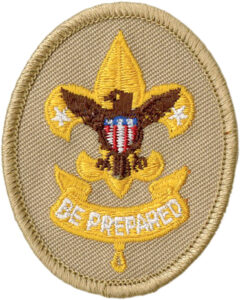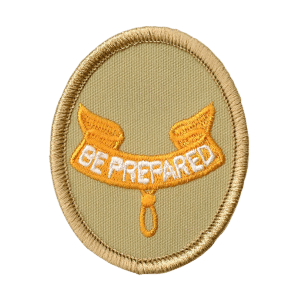The First Class rank marks an important level in Scouting, emphasizing a Scout’s growing knowledge of outdoor survival, community involvement, leadership, and personal responsibility. As a matter of fact, Lord Baden Powell, the founder of Scouting, said that even if a Scout doesn’t achieve the rank of Eagle, they should all earn First Class. Here’s a comprehensive look at each requirement with tips and strategies for success.
1. Troop/Patrol Activities and Outdoor Experience
- Requirement 1(a): Participate in 10 separate troop/patrol activities, with at least six outdoor activities, and three overnight camping experiences. During campouts, spend the night in a tent that you or your group sets up, like a lean-to, snow cave, or tepee.
- Tips:
- Plan Ahead: Be sure to attend troop activities regularly, as you’ll need 10 separate outings to fulfill this requirement.
- Practice Tent-Pitching: Setting up a tent on your own can be tricky, so practice with different types to ensure you’re prepared. Knowing how to pitch a tent properly keeps you safe and comfortable during campouts.
- Gear Preparation: Have a well-packed backpack that includes essentials like a sleeping bag, rain gear, first-aid kit, flashlight, and food. This helps you stay ready for any weather or campout condition.
- Track your Events: You should keep a log of your camping nights and troop events so you can show your counselor when and what you took part in.
- Requirement 1(b): Explain the principles of Tread Lightly! and demonstrate how you practiced them on an outing.
- Tips:
- Learn the Tread Lightly Principles: These principles include respecting nature, staying on trails, and minimizing waste. Study each one, and apply them during outings.
- Document Your Practices: Note specific ways you used the principles during campouts, such as packing out trash, following trails, or avoiding disturbing wildlife.
- For for information, check out this page!
2. Planning and Cooking Meals Outdoors
- Requirement 2(a): Plan a menu for a campout that includes breakfast, lunch, and dinner, with two meals requiring cooking. Ensure the menu aligns with USDA’s MyPlate nutritional guidelines.
- Tips:
- Balanced Meal Planning: Focus on meals with protein, vegetables, grains, and fruits for balanced nutrition. Think of easy-to-cook camping meals, such as scrambled eggs with veggies, sandwiches, and grilled chicken with rice.
- Prepare a Shopping List: Based on your menu, list ingredients and consider any specific needs, like extra water for hydration.
- Requirement 2(b): Create a budget and list the food quantities needed to feed at least three people based on your planned menu. Obtain the ingredients.
- Tips:
- Compare Prices: Check prices at different stores and choose items that fit your budget. Bulk items are often cheaper for group meals.
- Portion Control: Calculate quantities to avoid food waste while ensuring everyone has enough.
- Requirement 2(c): Identify the gear required for cooking and serving meals, such as pots, utensils, and plates.
- Tips:
- Compact and Efficient Gear: Choose lightweight, compact cooking gear suitable for camping, such as a small pot, spatula, and reusable plates.
- Requirement 2(d): Demonstrate safe handling and storage of perishable foods and appropriate trash disposal.
- Tips:
- Food Safety: Store perishables in a cooler and use ice packs to maintain temperature. Pack biodegradable bags for compostable items and designated trash bags for other waste.
- Requirement 2(e): Serve as the cook on a campout, supervising meal preparation, cooking, and cleanup.
- Tips:
- Plan Your Cooking Timeline: Assign roles to assistants, like fire-building or ingredient prep, to make meal preparation smoother.
- Organize Cleanup: Set up a wash station with water, biodegradable soap, and sponges to handle dishes efficiently.
3. Pioneering Skills with Lashings
- Requirement 3(a): Understand when to use lashings and when they are unnecessary.
- Tips:
- Lashings are essential for building camp structures, but for temporary or light items, simpler knots may be enough. Know the context for each.
- Requirement 3(b): Tie the timber hitch and clove hitch.
- Tips:
- Practice each knot individually until you can tie them from memory. The timber hitch is useful for hauling, while the clove hitch anchors objects securely.
- You can learn more about the knots you need to know in scouting here.
- Requirement 3(c): Tie the square, shear, and diagonal lashings to connect two or more poles.
- Tips:
- Square Lashing: Best for making right angles.
- Shear Lashing: Perfect for creating tripod structures.
- Diagonal Lashing: Useful for reinforcing crossed poles. Practice each lashing repeatedly to ensure they are strong and secure.
- Requirement 3(d): Use lashings to construct a useful camp gadget or structure.
- Tips: Common gadgets include tripods for cooking or a wash basin stand. Use sturdy materials and make sure lashings are tight and functional.
4. Navigation Skills
- Requirement 4(a): Use a map and compass to complete a one-mile orienteering course, including measuring the height or width of objects.
- Tips:
- Practice Orienteering Basics: Familiarize yourself with map symbols, scales, and compass bearings.
- Object Measurements: Use basic geometry or a tree height estimation technique.
- Requirement 4(b): Use a handheld GPS or GPS app to find your location and navigate to a destination.
- Tips:
- Learn Key GPS Functions: Understand how to set waypoints, track routes, and save your location.
- Battery Life: Make sure your GPS device is fully charged or carry backup batteries.
5. Nature Identification and Weather Preparedness
- Requirement 5(a): Identify or show evidence of 10 kinds of native plants.
- Tips: Use a plant identification guide or app and take photos to help remember different species. Focus on distinctive features like leaves and flowers.
- Requirement 5(b): Identify two ways to obtain a weather forecast and explain its importance.
- Tips: Common methods include checking local news and using weather apps. Be aware of how forecasts influence decisions for safe outdoor activities.
- Requirement 5(c): Describe three natural indicators of hazardous weather and appropriate actions.
- Tips: Thunderstorms, dark clouds, and sudden temperature drops can indicate bad weather. Plan to seek shelter if any signs appear.
- Requirement 5(d): Discuss extreme weather risks in your area and how to prepare.
- Tips: Research risks like hurricanes, extreme heat, or floods. Know the emergency supplies and gear needed for each scenario.
6. Aquatic Skills and Water Safety
- Requirement 6(a): Complete the BSA swimmer test.
- Tips: Practice swimming laps and building endurance to meet the required distance.
- Requirement 6(b): Discuss precautions for a safe trip afloat.
- Tips: Understand basics like wearing life jackets, loading the boat evenly, and staying seated.
- Requirement 6(c): Identify parts of a boat, paddle, or oar.
- Tips: Review diagrams and practice identifying parts on an actual boat if possible.
- Requirement 6(d): Explain proper body positioning in watercraft.
- Tips: Stability is key. Center your weight and avoid sudden movements to keep the boat balanced.
- Requirement 6(e): Perform a line rescue in deep water.
- Tips: Focus on communication with the “victim” and practice throwing a line accurately.
7. Emergency Preparedness and First Aid
- Requirement 7(a): Show how to apply bandages for common injuries like sprains and fractures.
- Tips: Carry a basic first aid kit and practice wrapping bandages on different body parts.
- Requirement 7(b): Demonstrate methods for transporting an injured person with a partner.
- Tips: Learn techniques such as the fireman’s carry and two-person lift. Practice with a friend.
- Requirement 7(c): Explain the signs of a heart attack and steps for CPR.
- Tips: Familiarize yourself with these signs, such as chest pain, and know the initial steps for CPR.
- Requirement 7(d): Identify potential hazards with utility services in your home and how to respond.
- Tips: Understand risks of gas leaks, electrical fires, and water issues. Discuss these with your family.
- Requirement 7(e): Develop an emergency action plan for home disasters.
- Tips: Include evacuation routes, meeting spots, and emergency contacts.
8. Fitness and Health
- Requirement 8(a): Be physically active for 30 minutes a day, five days a week, for four weeks.
- Tips: Choose activities you enjoy, like biking or hiking, to stay motivated.
- Requirement 8(b): Share your physical activity goals and progress.
- Tips: Reflect on your progress and set a new fitness goal, such as running a mile faster.
9. Citizenship and Community Awareness
- Requirement 9(a): Meet with a community leader to discuss U.S. citizenship.
- Tips: Prepare thoughtful questions about rights and duties to get an insightful perspective.
- Requirement 9(b): Research an environmental issue that affects your community. Share what you learned about this issue with your patrol or troop.
- Tips:
- Find Relevant Issues: Look into local environmental concerns, like water quality, air pollution, recycling efforts, or deforestation. You can find information through local news sources, environmental organizations, or government reports.Connect with Local Experts: If possible, reach out to a local environmental agency or nonprofit organization to gain a deeper understanding of the topic. These experts can provide data and practical insights into the issue.
- Requirement 9(c): Investigate an aspect of U.S. history that is relevant to you and share what you learn with your counselor.
- Tips:
- Choose a Personal Connection: Think of historical topics that resonate with you, like local historical landmarks, the heritage of your community, or even family history that ties into larger national events.
- Explore Various Sources: Libraries, local historical societies, and reputable online resources can offer detailed information. Use primary sources like documents, photos, and letters when possible to add depth to your understanding.
- Requirement 9(d): Develop a list of your rights and obligations as a U.S. citizen.
- Tips:
- Research Core Rights: Familiarize yourself with the Bill of Rights, as well as key amendments and constitutional rights that affect citizens daily, such as freedom of speech, the right to vote, and the right to privacy.
- Understand Civic Duties: Besides rights, understand your responsibilities as a citizen, such as obeying laws, paying taxes, and serving on a jury. Think about how these obligations contribute to a functioning society.
10. Scout Spirit and Service Hours
- Requirement 10: Demonstrate Scout spirit by living according to the Scout Oath and Scout Law in your everyday life.
- Tips:
- Reflect Daily: Make a conscious effort each day to follow the principles of the Scout Oath and Law. This can include small acts of kindness, honesty, and helpfulness in your school, family, and community.
- Document Your Efforts: Keep a journal noting specific ways you demonstrated Scout spirit. For example, if you helped a friend in need or completed a chore without being asked, write it down as a reminder of how you are embodying these values.
- Requirement 10(a): Participate in at least three hours of service through one or more approved projects.
- Tips:
- Choose Meaningful Service Projects: Select projects that align with your interests or community needs, like helping at a food bank, cleaning up a local park, or assisting at a community event.
- Complete All Hours: Ensure the project(s) you choose collectively add up to a minimum of three hours. This service work emphasizes the value of giving back to your community.
11. Scoutmaster Conference and Board of Review
For a complete guide to the Scoutmaster Conference and Board of Review Process, check out my full post here.
Conclusion
Earning the First Class rank is a commendable achievement, representing a Scout’s mastery of essential outdoor skills, dedication to service, and commitment to upholding the values of Scouting. By completing these requirements, Scouts gain confidence, knowledge, and a deeper connection to their community and the natural world. Following this guide, practicing consistently, and seeking guidance from leaders and fellow Scouts will ensure a successful path to First Class and beyond.





